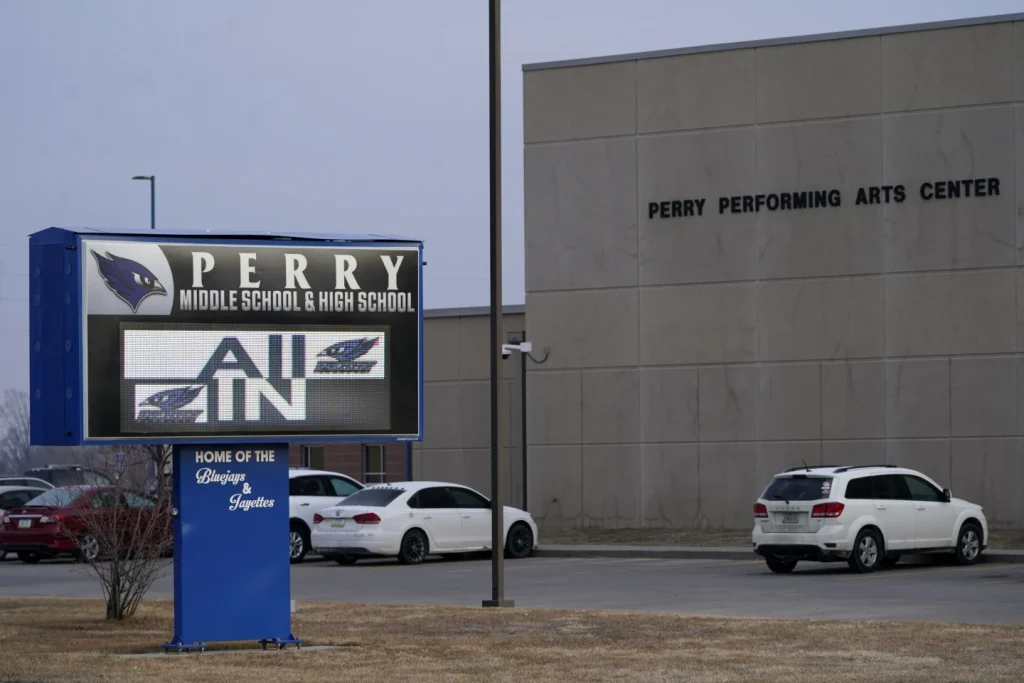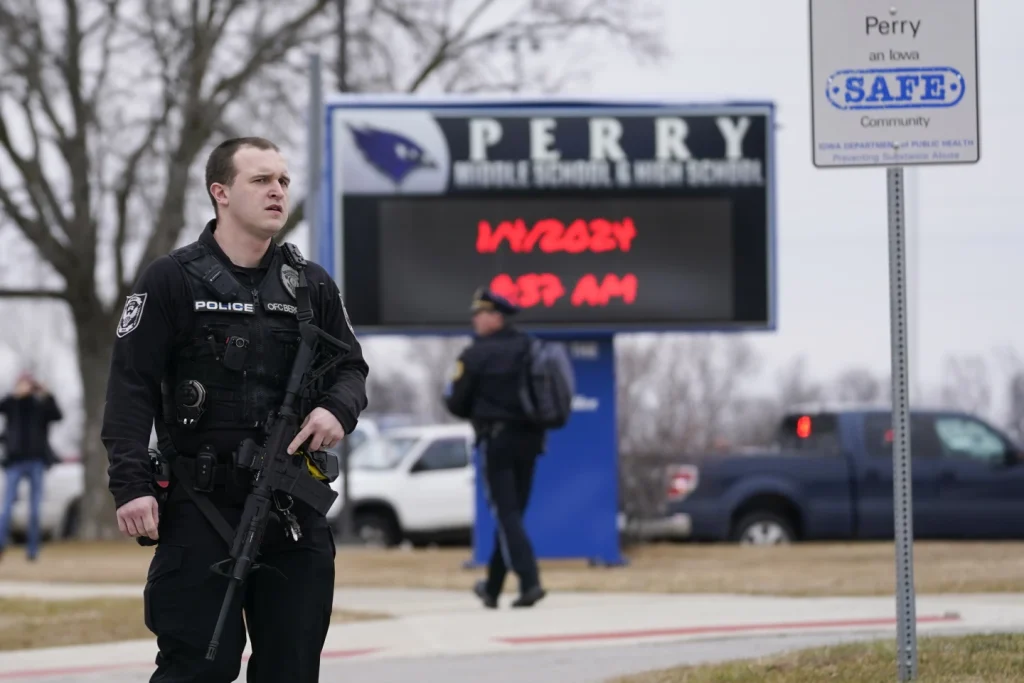The recent tragic school shooting in an Iowa town has once again ignited the urgent need for enhanced preventative measures and transparency within educational institutions.
The devastating loss of lives, including the critical injury of Principal Dan Marburger, has left the community reeling and demanding immediate action to ensure the safety and well-being of students, staff, and faculty members.
As concerned parents and community members voiced their apprehensions during a Perry school board meeting, it is evident that the call for more stringent safety protocols is not only a plea but a necessity to prevent such catastrophic events in the future.
The impassioned pleas of Grace Castro and Mark Drahos reflect the deep-seated concerns of many parents within the community.
Grace Castro’s critique of the school district’s policies, attributing the loss of lives to the lack of preventative measures, highlights the urgency of the situation.
Her proposals, including the installation of metal detectors at school entrances, the implementation of a temporary remote learning option, and the enforcement of a clear-bag policy, underscore the need for comprehensive safety measures that encompass both physical security and adaptability to unforeseen circumstances.
Similarly, Mark Drahos’ plea for more preventative measures, coupled with his acknowledgment of the challenges faced by school officials, emphasizes the complexity of the issue.
His suggestions, such as a single-point entry to buildings, a no-bag policy, and additional security measures like hall monitors, underscore the multifaceted nature of school safety, requiring a holistic approach that addresses various vulnerabilities within educational environments.
In addition to the demand for enhanced preventative measures, the call for transparency and collaboration between school officials and the community is equally vital.
The tragic events have underscored the need for open communication and active involvement of all stakeholders in the formulation and implementation of safety protocols.
Transparency not only fosters trust but also ensures that the concerns and suggestions of parents and community members are duly considered in the decision-making process.
Furthermore, collaboration between school officials, parents, and local authorities is indispensable in developing comprehensive safety strategies that are both effective and sustainable.
By fostering a collaborative approach, schools can leverage the expertise and insights of various stakeholders, thereby enhancing the efficacy of safety measures and promoting a collective responsibility towards ensuring a secure learning environment for all.
The tragic incident in the Iowa town underscores the pivotal role of preventative measures in mitigating the risks associated with potential security threats within educational institutions.
While it is impossible to eliminate all risks, the implementation of robust safety protocols can significantly reduce the likelihood of such catastrophic events.
Measures such as the installation of metal detectors, clear-bag policies, single-point entry systems, and additional security personnel are crucial in fortifying the physical security of schools and deterring potential threats.
Moreover, the incorporation of flexible learning options, such as temporary remote learning, can serve as a contingency plan in the event of unforeseen emergencies, ensuring the continuity of education while prioritizing the safety of students and staff.
By proactively addressing vulnerabilities and adapting to evolving security challenges, schools can effectively fortify their defenses against potential threats, thereby safeguarding the well-being of the entire school community.
The recent school shooting in the Iowa town has brought to the forefront the imperative for enhanced preventative measures and transparency within educational institutions.
The impassioned appeals of concerned parents and community members underscore the urgent need for comprehensive safety protocols that prioritize the well-being of students, staff, and faculty members.
As the school board deliberates on the path forward, it is imperative to heed the calls for enhanced safety measures, foster transparency, and engage in collaborative efforts that prioritize the security and well-being of all individuals within the educational community.
Only through a concerted and proactive approach can schools effectively mitigate the risks associated with potential security threats, thereby creating a safe and conducive learning environment for all.
The recent tragic events at Perry High School have left the community reeling and in mourning. The senseless act of violence that took the life of sixth-grader Ahmir Jolliff and injured several others has shaken the town to its core.
The heroic actions of teacher Jason Marburger, who sacrificed his own life to protect his students, have been a source of both sorrow and inspiration.
In the wake of this tragedy, the issue of school safety and mental health has once again come to the forefront.
Joseph Swanson’s words ring true as the community grapples with the question of how to prevent such a devastating event from happening again.
The call for an enhancement of security measures and a focus on mental health well-being is a crucial step in addressing the root causes of such violence.
The postponement of Monday’s meeting due to Marburger’s death serves as a stark reminder of the impact of this tragedy.
The funeral services for Marburger and the escort of his body back to Perry will be a somber occasion, as the community comes together to honor his bravery and sacrifice.
The encouragement for community members to line the route to welcome him back home is a testament to the deep sense of loss felt by all.

The reopening plan for the school is on hold, as the district grapples with the aftermath of the shooting. The decision to seek the expertise of law enforcement and safety experts shows a commitment to ensuring the safety of students and staff.
The presence of uniformed officers on site as students return to school is a necessary step in providing a sense of security and reassurance.
The impact of the shooting has been far-reaching, with the injured students and staff members facing a long road to recovery.
The release of the last injured student from the hospital is a small glimmer of hope in the midst of tragedy.
The community’s resilience and support for the victims and their families is a testament to the strength and compassion of the people of Perry.
The death of the 17-year-old student who carried out the attack is a tragic reminder of the devastating consequences of such acts of violence.
The discovery of an improvised explosive device in the suspect’s belongings serves as a chilling reminder of the potential for even greater harm.
It is clear that a comprehensive approach to addressing school safety and mental health is necessary to prevent such tragedies in the future.
In the face of such heartbreak, the community of Perry must come together to support one another and work towards healing.
The loss of young Ahmir Jolliff and the heroic actions of Jason Marburger will not be forgotten, and their memory will serve as a reminder of the need for action in addressing the underlying issues that lead to such violence.
As the town mourns and begins to heal, the call for an enhancement of security measures and mental health well-being must be heeded in order to prevent such tragedies from happening again.
In a recent school board meeting, Erica Jolliff, the mother of Ahmir Jolliff, made a heartfelt plea on behalf of her son, asking that the individual responsible for a tragic event not be dehumanized by labels such as “school shooter” or “murderer.”
Instead, she emphasized the importance of recognizing his humanity by referring to him by his name, Dylan.
Furthermore, she urged the school district to thoroughly review the events leading up to the incident and implement comprehensive safety procedures to prevent similar tragedies from occurring in the future.
This poignant plea brings to light several critical issues that warrant careful consideration and reflection.
It underscores the significance of humanizing individuals involved in tragic events and the imperative need for proactive measures to ensure the safety and well-being of students within educational environments.
The power of language and its impact on shaping perceptions cannot be understated. When individuals are reduced to impersonal labels such as “school shooter” or “murderer,” it not only diminishes their humanity but also perpetuates a narrative that fails to acknowledge the complex factors that may have contributed to their actions.
By emphasizing the individual’s name, Erica Jolliff advocates for a fundamental shift in how we approach and discuss such incidents.
It serves as a reminder that every individual is multifaceted, and reducing them to a single defining characteristic is both unjust and detrimental to understanding the underlying causes of such tragedies.
Moreover, Erica Jolliff’s call for a comprehensive review of the events leading up to the incident and the implementation of robust safety procedures within the school district is a proactive and necessary step towards preventing future occurrences.
It is imperative for educational institutions to critically examine the circumstances that preceded such tragic events, identify potential warning signs, and address systemic issues that may have contributed to the breakdown of safety measures.
By doing so, schools can proactively create a safer and more supportive environment for their students, faculty, and staff.
In light of these considerations, it is crucial for school districts and educational authorities to prioritize the implementation of holistic approaches to student safety.
This involves fostering a culture of empathy, understanding, and support within school communities.
It requires the implementation of proactive measures, such as mental health support services, conflict resolution programs, and anti-bullying initiatives, to address underlying issues that may contribute to incidents of violence or harm.
Furthermore, it is essential for schools to establish clear and effective communication channels for reporting concerns and potential threats.
Students, parents, and staff should feel empowered to voice their concerns without fear of retribution, and mechanisms for addressing and investigating such concerns should be readily accessible and transparent.
In conclusion, Erica Jolliff’s impassioned plea serves as a poignant reminder of the importance of humanizing individuals involved in tragic events and the critical need for proactive measures to ensure the safety and well-being of students within educational settings.
By recognizing the humanity of individuals and implementing comprehensive safety procedures, schools can work towards creating a safer, more supportive, and inclusive environment for all members of the school community.

In the wake of such tragedies, it is incumbent upon educational institutions and communities to come together to address the underlying factors that contribute to such events and to work collaboratively towards creating a safer and more compassionate environment for all.
Only through a concerted effort to humanize individuals, understand the complex factors at play, and implement proactive safety measures can we hope to prevent similar tragedies from occurring in the future.
As we reflect on Erica Jolliff’s powerful words, let us reaffirm our commitment to fostering empathy, understanding, and safety within our schools, and to working towards a future where all individuals are valued, supported, and empowered to thrive.
